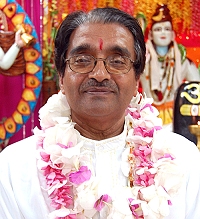Paramacharya of SWAHA, Pt. Hardeo Persad
Hinduism is a deeply philosophical religion that is rich in mythological stories that encode within them universal truths. The goal of worship is to connect with that universal Divine within us. While many people worship for the love of worshipping, which is admirable, the concept of gyaan bhakti is important: we must understand the reasoning behind what we do, in terms of the rituals and prayers. There are three different methods through which the mysteries of this world can be unravelled: the experimental outlook, which includes the mythological stories; the cosmological path, which includes the universal laws that guide us through life, and the metaphysical way, which is the deepest method, in that it relates the universal concepts to the individual. It is the concept that all the qualities of the Divine exist within the individual. As the Vedas have stated, “As in the microcosm, so in the macrocosm.”
Hinduism is replete with symbolism and imagery. All the forms of the Divine represent universal principles that exist in nature and the self. In Hinduism there are many wonderful forms of the Divine Mother. It is one of the few religions at present that speak of the Goddess. Devi’s main forms are Durga, Lakshmi, Saraswati and Kaali. Durga represents Icchhaa Shakti, the power of will; Lakshmi is Gyaan Shakti, the power of wisdom; Saraswati is Kriyaa Shakti, the power of enlightened activity and Kaali is the power of time. There are also the Das Mahaa Vidyas, the ten forms of transcendental knowledge. Kaali is the first; Taara Devi is the power of hunger; Shodasi Devi is the power of perfection; Bhuvaneshwari Devi, the power of knowledge; Chinnamasta Devi, the power of self sacrifice; Bhairavi Devi, the power of death; Dhoomavati Devi, the power of poverty; Bhagalamukhi Devi, the power of cruelty; Maatangi Devi, the power of domination; and Kamala Devi, the power of wealth. There are numerous other aspects of Devi: Ishwari, Parameshwari, Kaumari, Kalyaani, Katyaayani, to name a few. However, it should be emphasised that there is only one Shakti.
Devi is the primordial energy and her aspects are the various personifications and functions of that energy. There are various manifestations of energy: light energy, sound energy, heat energy, electromagnetic energy, electrical energy; all the different forms of energy are personified as Devis in Hinduism. Furthermore, all these principles of Devi exist inside every individual. When I worship Durga Devi, for example, I connect with the willpower inside me and I can overcome all external negativities. The purpose of all the forms of religious self-sacrifice that we make is to connect with these divine powers that are dormant inside each of us. Therefore, the spiritual journey is inward. We each have to connect with the Divine power for ourselves. Then we will gain that confidence that the Lord is with me wherever I am.
In the Devi Kavach, we ask all the various forms of Devi to protect the various parts of the body. These are the different energy fields that are activated when that mantra is chanted. Each form of the Devi that is invoked represents a type of impulse or energy that exists within the human body. Everything is energy vibrating at different frequencies. Matter is energy and the base of energy is vibrations. This is in sync with Einstein’s theory of E=MC². By worshipping Devi, we access the energy within. There are seven main energy vortices in the body, each of which control specific organs in the body. To prevent illness, we must energize the chakras, especially if they are underfunctional and non-functional. We do this by worshipping the divine female aspect, Devi.



